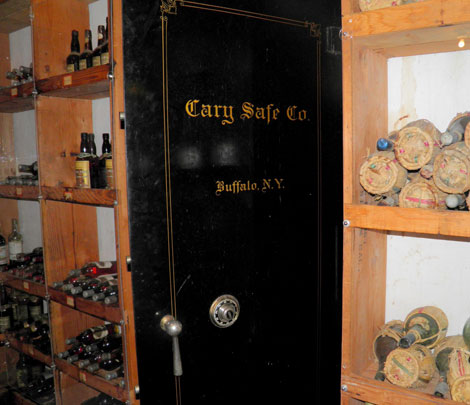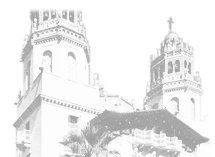 Consisting of two rooms with double vault doors, the wine cellar is part of the Casa Grande basement and can be seen on the Cottages & Kitchens Tour.
Consisting of two rooms with double vault doors, the wine cellar is part of the Casa Grande basement and can be seen on the Cottages & Kitchens Tour.
On June 14, 1922, Morgan wrote to Hearst:
“The basement purposely has no connections between sections – for fire and thief protection … Work is well under way on the basement excavating – but is slow as the charges of dynamite have to be small!”
Hearst replied on July 8th:
“I like the basement layout very much and appreciate the value of having the different parts of the basement separated by fireproof walls.”
As additions to Casa Grande were made, the basements were enlarged and eventually more than 9000 square feet of separate basement rooms were created, most used as storage vaults.
Construction
Located below the north end of the Assembly Room, the wine cellar is inconvenient with relation to the kitchen. However, the cellar’s placement was probably dictated by the need for an even, cool temperature, which was more easily maintained on the north side of the building. Ideally, wines should be stored at 45 – 60 degrees Fahrenheit because higher temperatures can cause wine to mature too rapidly. According to housekeeper Ann Miller, Hearst did have some type of cooling equipment in the wine cellar, but there has been no artificial cooling since the estate was deeded to California State Parks. Bottles are stored on their side so that the cork does not dry out and allow air to enter. Exposure to air will spoil wine, although liqueurs and spirits are usually not affected. Another concern in storing wine is light, an excessive amount of which makes the wine taste musty or flat.
The iron doors were installed as early as 1924. Mr. Hearst’s secretary, Joe Willicombe, wrote to Julia Morgan in August of 1924: “Mr. Hearst told me to tell Mr. Rossi [the construction superintendent] to put the iron doors on the wine vault. Mr. Hearst wants to lock the vault and take the keys with him. He does not consider the wooden doors any protection against possible thievery.” By all accounts, the wine cellar doors were always kept locked; as Hearst employee Wilfred Lyons jokingly said in an interview: “Mr. Hearst would lock up his cellar and you couldn’t get into it. I mean even the butler had to order ahead.”
Prohibition 1920 – 1933
 The Eighteenth Amendment prohibiting the manufacture, sale or transportation of alcohol in the United States had taken effect in 1920 and was not to be repealed until 1933, but that seemed to give little pause to Hearst’s wine cellar plans. It does explain, however, his insistence on locked iron doors. Throughout the Prohibition era, he continued to serve alcohol to his guests. His editorial stance was for temperance but against Prohibition because the prohibition was unenforceable and aided organized crime. In 1929 his newspapers conducted a nationwide contest with a $25,000 award for the best plan for the repeal of Prohibition. He wrote: “I consider the Eighteenth Amendment not only the most flagrant violation of the basic American principle of personal liberty that has ever been imposed on the American public, but the most complete failure as a temperance measure that has ever been conceived and put into impractical operation.”
The Eighteenth Amendment prohibiting the manufacture, sale or transportation of alcohol in the United States had taken effect in 1920 and was not to be repealed until 1933, but that seemed to give little pause to Hearst’s wine cellar plans. It does explain, however, his insistence on locked iron doors. Throughout the Prohibition era, he continued to serve alcohol to his guests. His editorial stance was for temperance but against Prohibition because the prohibition was unenforceable and aided organized crime. In 1929 his newspapers conducted a nationwide contest with a $25,000 award for the best plan for the repeal of Prohibition. He wrote: “I consider the Eighteenth Amendment not only the most flagrant violation of the basic American principle of personal liberty that has ever been imposed on the American public, but the most complete failure as a temperance measure that has ever been conceived and put into impractical operation.”
Alcohol and Wine at the Castle
Hearst himself was a moderate drinker. His son William Randolph Jr., says: “he never touched Scotch or gin, but enjoyed a glass of wine or beer with most of his meals. After dinner I don’t remember ever seeing him drink brandy, but he had a sweet tooth for liqueurs like Cointreau, Benedictine and creme de menthe.” Bill Jr., also wrote: “Evenings would begin with cocktails before dinner – whether it was a weekend party or a big birthday gala. Guests usually limited themselves to one drink. Pop did not like hard liquor or heavy drinking. He put the word out that no guests were to bring their own booze to the place. But some did and got drunk. He would have someone ask them to leave, and they would be driven to the train station at San Luis Obispo.”
Although San Luis Obispo County is today a wine-producing area, it was not so in W.R. Hearst’s time. The many grapes grown in the Pergola area were used for eating only, and, as far as is known, Hearst never expressed a desire to make wine, although he was playing the role of gentleman farmer in almost every other aspect. In Hearst’s time the finest wine was from France and Germany. This is reflected in Hearst’s wine collection. There were relatively few California wines; the bulk was from the Alsace, Bordeaux, and Burgundy regions in France and the Rhine and Moselle regions in Germany.


